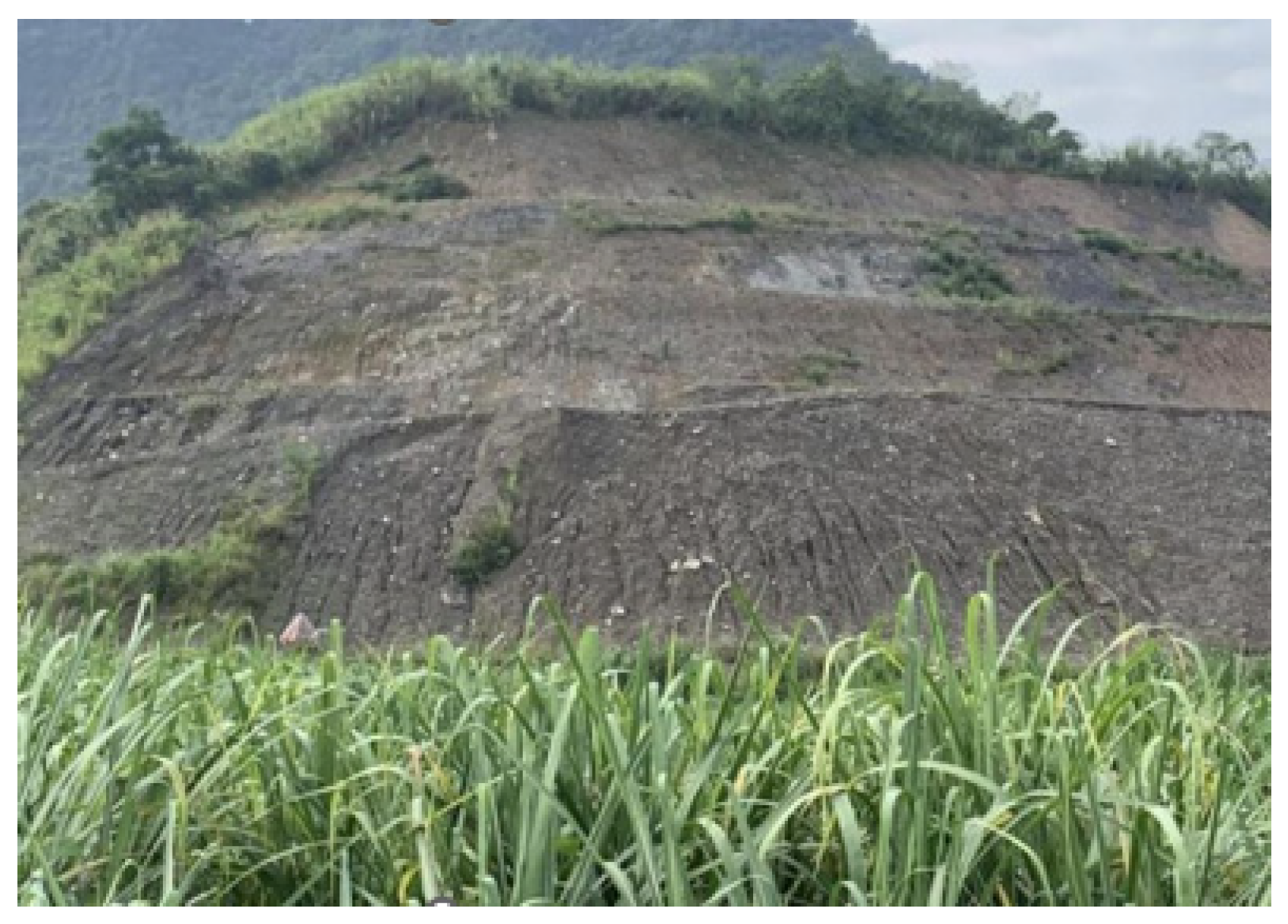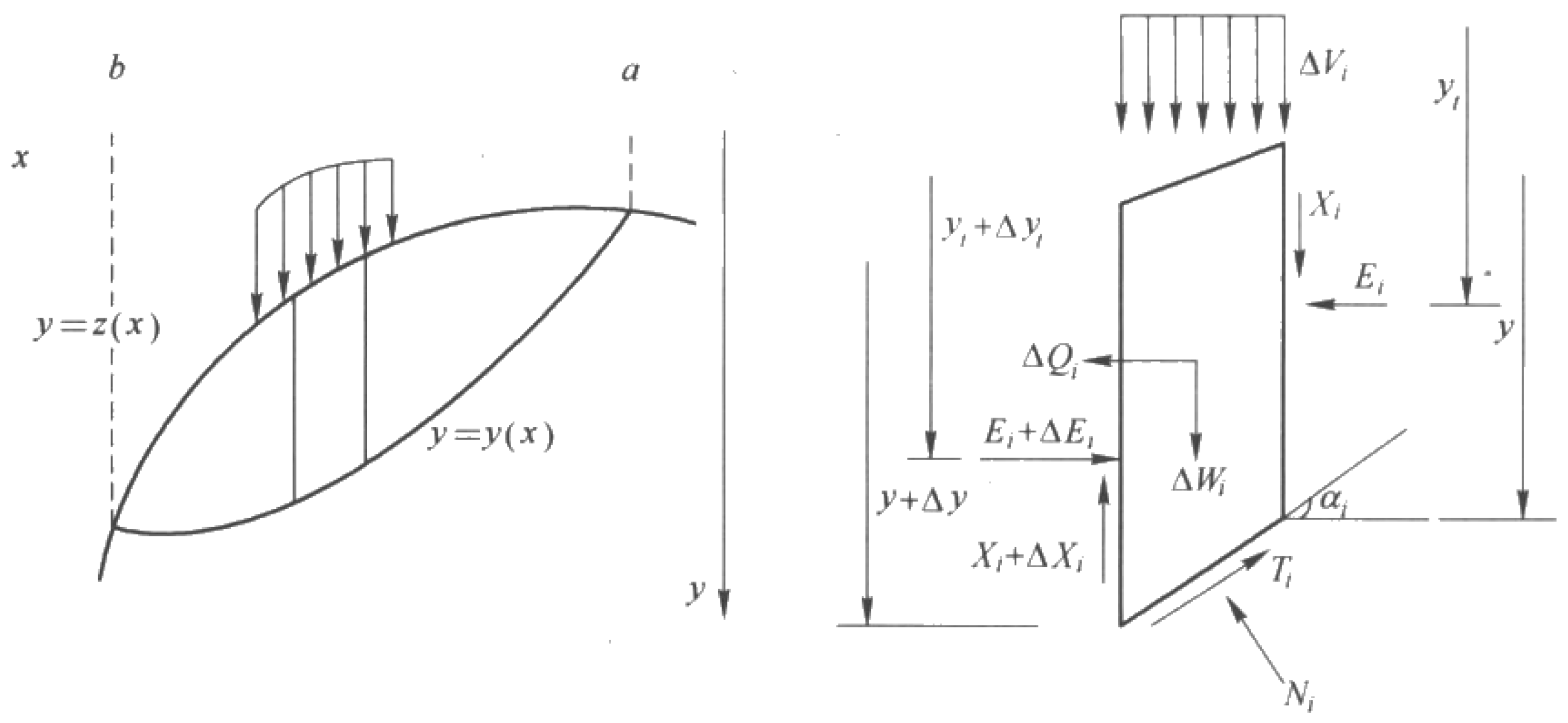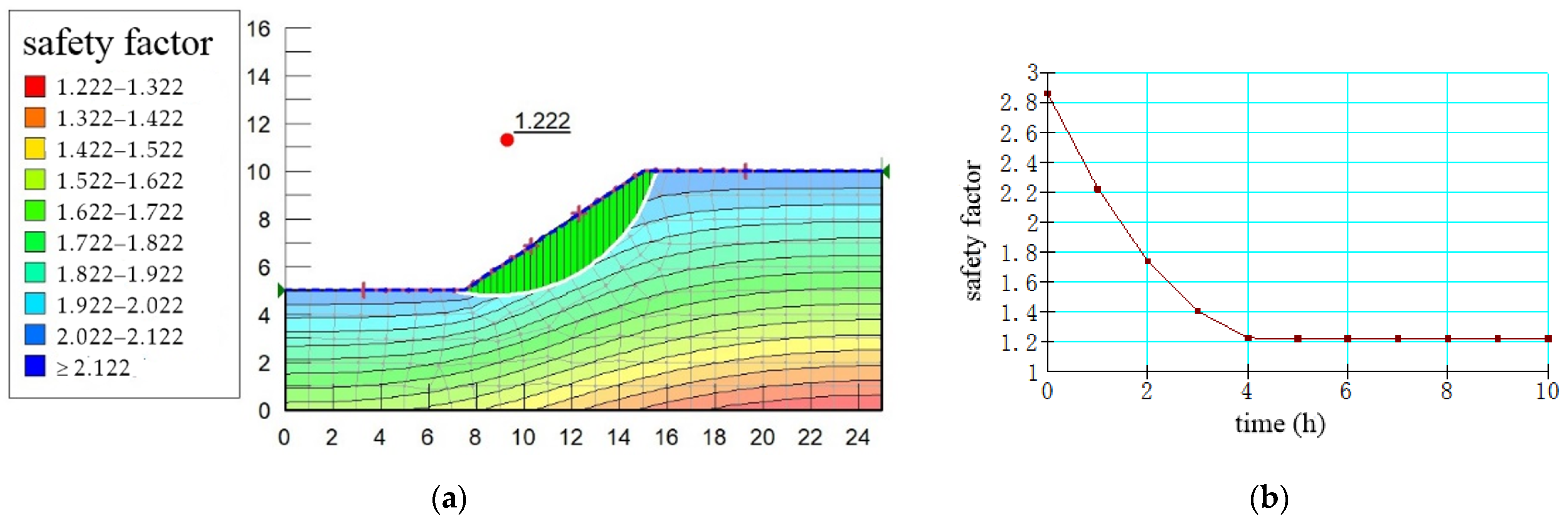Study on the Stability of High and Steep Slopes of Open-Air Dump with Various Slope Ratios Under Rainfall Conditions
Abstract
:1. Introduction
2. Study Area Overview
3. Data and Methods
3.1. Soil Parameters
3.2. Numerical Simulation Software and Steps
3.2.1. The Basic Principle of Limit Equilibrium Method
- (1)
- The deadweight of the soil strip ΔWi, its magnitude, position and direction of action point are known.
- (2)
- The normal stress at the bottom of the strip is Ni, and the tangential stress is Ti. Assume that Ni and Ti act at the midpoint of the sliding surface, and their magnitudes are unknown.
- (3)
- The normal forces on both sides of the soil strip are Ei and Ei + ΔEi, and the vertical shear forces are Xi and Xi + ΔXi.
- (4)
- ΔQi is the horizontal inertial force (i.e., horizontal seismic force), and the distance between its action point and the soil strip is hei.
- (5)
- The vertical load qΔx on the slope surface.
- (6)
- The angle between the normal line (i.e., the radius of the arc) of the sliding surface of soil strip i and the vertical line is αi; the cohesion of the soil on the sliding surface is c, and the internal friction angle is φ.
((dWi)/dx + (dVi)/dx)(tanφe − tanαi) − (dQi)/dx(1 + tanφe tanαi)
3.2.2. Numerical Simulation Steps
4. Stability Analysis of Single-Step Slope with Different Slope Ratios Under Rainfall Conditions
4.1. Changes in Slope Stability Under Continuous Rainfall
4.2. Changes in Slope Stability at Different Step Heights with the Same Slope Ratio Under Continuous Rainfall
4.3. Stability Changes of Different Slope Ratios Under Short-Term Heavy Rainfall
5. Discussion
- (1)
- The simulation results indicate that rainfall infiltration significantly affects slope stability. During the 10 h rainfall simulation, the following trends were observed: In the early stages of rainfall, the safety factor decreases sharply as water begins to infiltrate the slope. This is due to the rapid increase in pore water pressure, which results in a corresponding reduction in effective stress. After 4–5 h of rainfall, the soil reaches saturation, and the rate of decrease in the safety factor slows down. At this point, the permeability and drainage rate of the soil tend to reach equilibrium. After 10 h of rainfall, the safety factors of some slopes approach critical values, especially for steeper slopes, indicating that the slope is on the verge of instability due to increased pore water pressure caused by water accumulation in the soil.
- (2)
- The impact of slope ratio on stability is significant. Under rainfall conditions, steeper slopes exhibit poorer stability. The rate of decrease in the safety factor for steep slopes (e.g., 1:1.5) is much faster than for gentler slopes (e.g., 1:2.25). This is attributed to the fact that steeper slopes concentrate the forces acting on the soil, thereby increasing shear stress and reducing shear strength, making the slope more prone to failure. For slopes with ratios of 1:1.5 and 1:1.75, failure occurs after 7–8 h of rainfall, especially for slopes exceeding 10 m in height, where the safety factor decreases significantly, reaching a minimum of 0.9. In contrast, slopes with gentler ratios (1:2.0 and 1:2.25) exhibit better stability. For example, a slope with a ratio of 1:2.25 maintains a safety factor above 1.1 even after 10 h of rainfall.
- (3)
- The results of this study have important implications for slope design and maintenance in areas prone to rainfall and erosion. In regions with frequent rainfall, slope designs should adopt gentler slope ratios (e.g., 1:2.0 or 1:2.25) to minimize the risk of instability. Steep slopes, especially those with greater heights, should be avoided, as they are more susceptible to collapse during prolonged rainfall. For existing slopes, measures such as improving drainage, reducing water infiltration, or using stabilization techniques (e.g., slope reduction and counterpressure at the slope foot) can help maintain stability during heavy rainfall events.
- (4)
- Although the results provide a solid basis for decision-making, this study also has some limitations. The study relied entirely on numerical simulation for stability analysis, and the model was not calibrated and verified by physical experimental models or field monitoring data. Although the simulation results are consistent with theoretical expectations, they are not directly compared with the actual slope behavior, which may affect the applicability of the model in real complex geological conditions. In the future, the numerical model should be verified by physical experiments and field monitoring data to improve the empirical reliability of the results; the simulation assumes homogeneous soil conditions, while in reality, the cohesion, permeability and compaction of the soil may vary. Future research should also consider the impact of soil heterogeneity on slope stability. In addition, this study focuses on short-term heavy rainfall events, while long-term low-intensity rainfall may have different effects on slope stability. Future research should explore the impact of such events on long-term slope stability. Although the numerical simulation results provide valuable theoretical insights, further field studies and verification using real data are needed to confirm the research results and improve modeling techniques.
6. Conclusions
- (1)
- As rainfall infiltrates the slope soil, the soil moisture content gradually increases. When the soil pores approach saturation, the capillary tension and suction in the soil decrease, leading to a reduction in matric suction and weakening the soil strength. During rainfall, if the infiltration rate exceeds the drainage rate, water accumulates within the soil, increasing pore water pressure. As pore water pressure rises, the effective stress in the soil decreases, causing the slope to lose its original shear strength.
- (2)
- Steeper slopes are more prone to accumulating large amounts of surface runoff under heavy rainfall or prolonged precipitation, which increases the soil moisture content and pore water pressure, thereby weakening the soil’s shear strength and increasing the risk of instability. In contrast, gentler slope ratios allow for a more uniform distribution of stresses, reducing localized stress concentrations and enhancing the overall stability of the slope. Additionally, gentler slopes aid in drainage, reducing pore water pressure buildup and mitigating the negative impacts of rainfall infiltration on slope stability.
- (3)
- According to the stability analysis results of single-step slopes under sustained rainfall, when the slope height is less than or equal to 5 m, a slope ratio of 1:1.5 is appropriate. For step heights between 5 and 15 m, a slope ratio of 1:1.75 meets the stability requirements. For step heights ranging from 15 to 25 m, a slope ratio of 1:2.0 can be selected. A slope ratio of 1:2.25 is suitable for single-step slopes with heights up to 30 m.
- (4)
- In slope design and remediation, the slope ratio should be chosen based on the specific conditions. For high and steep slopes, measures such as slope reduction, drainage systems, and counterpressure at the slope foot should be implemented to improve stability. In areas with dense cracks, it is recommended to enhance the drainage design to prevent excessive water accumulation within the soil, which may lead to instability.
- (5)
- To address local instability within the internal slopes of the dump site, several stabilization measures can be implemented. One approach is to construct a placement platform at the toe of the dump slope to exert a certain amount of counteracting horizontal pressure, which is particularly suitable for areas with sufficient space at the slope toe and where additional support for the toe embankment is required. Another method involves slope trimming to reduce the overall slope gradient and increase platform areas, thereby decreasing the slope height. If the earthwork volume required for slope trimming is excessive, a combined approach incorporating counterweight berms at the slope toe can be considered. In addition to these two remediation methods, further measures should be taken to ensure the long-term stability of the dump site. These include the installation of retaining structures, drainage interception and discharge systems, monitoring facilities, and land reclamation initiatives. These measures help ensure that the dump site meets the requirements of relevant standards and regulations, thereby enhancing overall stability and safety.
Author Contributions
Funding
Institutional Review Board Statement
Informed Consent Statement
Data Availability Statement
Acknowledgments
Conflicts of Interest
References
- Lan, Y. Stability Analysis and Treatment of High and Steep Slopes in Open-pit Mine Waste Dumps Based on Numerical Simulation. Min. Res. Dev. 2023, 43, 77–82. [Google Scholar]
- Li, F.; Wang, D. Research on the Slope Stability of Waste Dumps on Thick Loess Foundations. Saf. Coal Mines 2022, 53, 221–226. [Google Scholar]
- Liu, G.; Guo, W.; Du, H.; Cao, B.; Song, D. Research on the Deformation Law of the Filling Body in the Inner Dump of Open-pit Coal Mines. J. Saf. Environ. 2023, 23, 3081–3089. [Google Scholar]
- Chen, G. The Weakening Effect of Rainfall on the Slope Stability of the Dump on the Weak Foundation of Open-pit Mines. Min. Res. Dev. 2022, 42, 56–62. [Google Scholar]
- Liu, Y.; Wang, Y.; Shi, X.; Qiu, X. Study on the Slope Stability of Waste Rock Stockpiles Considering Rainfall Factors. Min. Metall. Eng. 2022, 42, 26–29. [Google Scholar]
- Zhou, Z.; Lian, M.; Sun, S. Research on the Influence Law of Different Rainfall Conditions on the Safety of the Dump. Met. Mine 2023, 8, 278–282. [Google Scholar] [CrossRef]
- Yang, Y.; Liu, H.; Li, H.; Su, S.; Liu, W.; Dong, Y.; Wang, D. Evaluation of the Reinforcement Performance of Loess Slopes Affected by Rainfall Infiltration. Geofluids 2022, 2022, 5359809. [Google Scholar] [CrossRef]
- Xiong, X.; Shi, Z.; Xiong, Y.; Peng, M.; Ma, X.; Zhang, F. Unsaturated Slope Stability Around the Three Gorges Reservoir under Various Combinations of Rainfall and Water Level Fluctuation. Eng. Geol. 2019, 261, 105231. [Google Scholar] [CrossRef]
- Sun, Z.-b.; Shu, X.; Dias, D. Stability Analysis for Nonhomogeneous Slopes Subjected to Water Drawdown. J. Cent. South Univ. 2019, 26, 1719–1734. [Google Scholar] [CrossRef]
- Zhang, C.; Clement, A.a.; Kodama, J.-i.; Sainoki, A.; Fujii, Y.; Fukuda, D.; Wang, S. Effect of the Connectivity of Weak Rock Zones on the Mining-Induced Deformation of Rock Slopes in an Open-Pit Mine. Sustainability 2024, 16, 5974. [Google Scholar] [CrossRef]
- Wu, S.; Ma, D.; Liu, Z.; Chen, L.; Chen, L.; Zhang, J. A Novel Approximate Solution to Slope Rainfall Infiltration. J. Hydrol. 2023, 625, 130039. [Google Scholar] [CrossRef]
- Su, Z.; Shao, L. A Three-Dimensional Slope Stability Analysis Method Based on Finite Element Method Stress Analysis. Eng. Geol. 2021, 280, 105910. [Google Scholar] [CrossRef]
- Liang, Z.; Wang, D.; Li, G.; Sun, G.; Yu, M.; Xia, D.; Ding, C. Three-dimensional Stability Calculation Method for High and Large Composite Slopes Formed by Mining Stope and Inner Dump in Adjacent Open Pits. Int. J. Min. Sci. Technol. 2024, 34, 507–520. [Google Scholar] [CrossRef]
- de Kooker, L.C.; Ferentinou, M.; Musonda, I.; Esmaeili, K. Investigation of the Stability of a Fly Ash Pond Facility Using 2D and 3D Slope Stability Analysis. Min. Metall. Explor. 2024, 41, 659–668. [Google Scholar] [CrossRef]
- Wang, J.; Wang, Z.; Sun, G.; Luo, H. Analysis of Three-Dimensional Slope Stability Combined with Rainfall and Earthquake. Nat. Hazards Earth Syst. Sci. 2024, 24, 1741–1756. [Google Scholar] [CrossRef]
- Zhang, F.; Pei, H. Stability Analysis of Shallow Slopes under Rainfall Infiltration Considering Tensile Strength Cut-off. Comput. Geotech. 2024, 171, 106327. [Google Scholar] [CrossRef]
- Guo, X.-g.; Ma, L.; Zhang, C.; Gan, S.-c.; Wang, H.; Gan, Y.-x.; Zhou, T. Research on the High-Speed Reverse Stacking and Stability Control Methods for the Slope of the Dump on Weak Foundations. Rock Soil Mech. 2024, 45, 596–606. [Google Scholar]
- Wang, F.; Zou, P.; Wang, Z.; Dai, Y.; Xiao, Z.; Liu, Z. Method and Application of Slope Stability Prediction Based on GA-BP Neural Network. J. Saf. Sci. Technol. China 2024, 20, 161–167. [Google Scholar]
- Li, C.; Zhang, R.; Zhu, J.; Lu, B.; Wang, X.; Xu, F.; Shen, X.; Liu, J.; Cai, W. Model Test Study on Response of Weathered Rock Slope to Rainfall Infiltration under Different Conditions. J. Earth Sci. 2024, 35, 1316–1333. [Google Scholar] [CrossRef]
- Azarafza, M.; Akgün, H.; Ghazifard, A.; Asghari-Kaljahi, E.; Rahnamarad, J.; Derakhshani, R. Discontinuous rock slope stability analysis by limit equilibrium approaches—A review. Int. J. Digit. Earth 2021, 14, 1918–1941. [Google Scholar] [CrossRef]
- Mebrahtu, T.K.; Heinze, T.; Wohnlich, S.; Alber, M. Slope stability analysis of deep-seated landslides using limit equilibrium and finite element methods in Debre Sina area, Ethiopia. Bull. Eng. Geol. Environ. 2022, 81, 403. [Google Scholar] [CrossRef]
- Cheng, Q.; Hou, K.; Sun, H.; Niu, X. Numerical Simulation of Rainfall-Induced Erosion on Infiltration and Slope Stability. Water 2024, 16, 1517. [Google Scholar] [CrossRef]
- Jiang, T.; Li, L.; Xue, L.; Huang, K.; Zhao, J.; Wang, L.; Wan, L.; Ding, H. Study on Synergistic Characteristics of Accumulation Landslides Supported by Arbor Species. Forests 2022, 13, 1610. [Google Scholar] [CrossRef]







| Geotechnical Parameters | Numerical Value |
|---|---|
| Heavy γ (kN/m3) | 16.7 |
| Cohesive force C (kPa) | 8 |
| Internal friction angle Φ (°) | 9 |
| relative density | 2.7 |
| Plastic limit (ω p/%) | 27.3 |
| Liquid limit (ω I/%) | 56.1 |
| Plasticity index (Ip) | 28.8 |
| Original soil dry density (ρ d/g/cm3) | 1.67 |
| Undisturbed soil moisture content (ω/%) | 54.2 |
Disclaimer/Publisher’s Note: The statements, opinions and data contained in all publications are solely those of the individual author(s) and contributor(s) and not of MDPI and/or the editor(s). MDPI and/or the editor(s) disclaim responsibility for any injury to people or property resulting from any ideas, methods, instructions or products referred to in the content. |
© 2025 by the authors. Licensee MDPI, Basel, Switzerland. This article is an open access article distributed under the terms and conditions of the Creative Commons Attribution (CC BY) license (https://creativecommons.org/licenses/by/4.0/).
Share and Cite
Zi, F.; Tang, L.; Cao, Y.; Xiao, Y. Study on the Stability of High and Steep Slopes of Open-Air Dump with Various Slope Ratios Under Rainfall Conditions. Appl. Sci. 2025, 15, 2965. https://doi.org/10.3390/app15062965
Zi F, Tang L, Cao Y, Xiao Y. Study on the Stability of High and Steep Slopes of Open-Air Dump with Various Slope Ratios Under Rainfall Conditions. Applied Sciences. 2025; 15(6):2965. https://doi.org/10.3390/app15062965
Chicago/Turabian StyleZi, Feng, Long Tang, Yunjiang Cao, and Yongjun Xiao. 2025. "Study on the Stability of High and Steep Slopes of Open-Air Dump with Various Slope Ratios Under Rainfall Conditions" Applied Sciences 15, no. 6: 2965. https://doi.org/10.3390/app15062965
APA StyleZi, F., Tang, L., Cao, Y., & Xiao, Y. (2025). Study on the Stability of High and Steep Slopes of Open-Air Dump with Various Slope Ratios Under Rainfall Conditions. Applied Sciences, 15(6), 2965. https://doi.org/10.3390/app15062965







